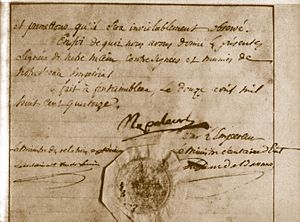Acte de déchéance de l'Empereur facts for kids
The Emperor's Demise Act (called Acte de déchéance de l'Empereur in French) was a special law passed on April 2, 1814. It was created by a group called the Sénat conservateur (Conservative Senate). This law officially removed Napoleon I from his position as Emperor of the French.
Contents
Why Napoleon Was Removed
For a long time, France had been at war with many countries in Europe. This started after the French Revolution removed King Louis XVI. Because the government was often unstable, it was easy for a military leader to take control.
Napoleon's Rise to Power
General Napoleon Bonaparte took advantage of this situation. In 1799, he led a takeover of the government. This created the French Consulate, where he was one of three leaders. Two years later, he became the First Consul for life, meaning he would lead forever.
Finally, in 1804, the Senate made him Emperor. He became "Napoleon I, Emperor of the French." He was crowned Emperor on December 2, 1804, starting the First French Empire.
Napoleon's Downfall
However, Napoleon faced many big problems and wars. These included the Peninsular War, the War of the Sixth Coalition, and the French invasion of Russia. These conflicts greatly weakened his powerful army, known as the Grande Armée.
By early 1814, the French army was very small. Even though Napoleon won some battles, he could not stop other European armies. These armies, called the Allies, marched into France and headed for Paris.
Talleyrand's Plan
The Allies reached Paris in late March 1814. A clever politician named Talleyrand started to make plans. He worked to arrange the surrender of Paris.
On March 31, Talleyrand met with the leaders of Prussia and Russia. He argued that France should bring back the old royal family, the Bourbons. He said the Senate would support this idea.
The Act Is Passed
On April 1, 1814, the Senate chose Talleyrand to lead a temporary government. This government had five members.
The very next morning, Talleyrand and the Senate's president, Barthélemy, made a big suggestion. They proposed a law to remove Napoleon and his family from power. They also suggested that the Count of Provence should become King Louis XVIII.
Reasons for Removal
On April 3, the Senate voted on a document. This document explained why they were removing Napoleon. It said that Napoleon had broken many rules of the Constitution. The Senate itself had approved this Constitution years before.
The details of this meeting were printed in the newspaper Le Moniteur Universel on April 4.
The final part of the law clearly stated:
- Napoleon Bonaparte is removed from the throne. His family can no longer inherit the right to rule.
- The French people and army are no longer loyal to him.
- This law will be sent to all parts of France and announced in Paris right away.
What Happened Next
On April 11, Napoleon tried to put his son on the throne. But he finally gave up completely. The Allies let him keep his title of Emperor. However, they sent him away to the island of Elba.
Napoleon tried to return to power on February 26, 1815. This period is known as the Hundred Days. But he was defeated at the Battle of Waterloo. After that, he was sent to the faraway island of Saint Helena for the rest of his life.
In the years that followed, the Emperor's Demise Act was important. It showed who was loyal to the new Bourbon kings.



